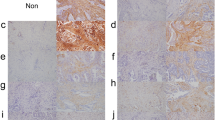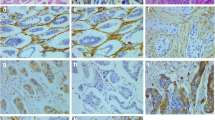Abstract
Purpose
Caveolin is an essential constituent of caveolae and has many biological functions. Expression of caveolin-1 in cancer cells was reported to be a prognostic marker in several types of cancers, the prognostic significance of its expression in cancer-associated fibroblasts (CAFs) has not been investigated. This study aimed to evaluate the clinicopathological significance of expression by CAFs in lung adenocarcinoma.
Methods
We examined caveolin-1 expression in both CAFs and cancer cells in stage I invasive lung adenocarcinoma (n = 412) and analyzed the relationship between the expression and clinicopathological factors.
Results
Caveolin-1 expression by CAFs and cancer cells was observed in 12.1% and 7.8% of adenocarcinomas, respectively. Tumors with caveolin-1-positive CAFs had vascular and pleural invasion significantly more frequently than those with caveolin-1-negative CAF (p < 0.05). This was also the cases with tumors with caveolin-1-positive cancer cells (p < 0.01). Caveolin-1 expression by CAFs and that by cancer cells were significant predictors of shorter recurrence-free survival (p < 0.001). Caveolin-1 expression by CAFs and cancer cells was found in 25% and 30% of solid predominant subtype, respectively, but only 9.2% and 2.7% of non-solid predominant subtype, respectively. The frequency of cases with caveolin-1-positive CAFs or cancer cells was significantly higher in the solid predominant subtype than in non-solid predominant subtype (p < 0.001).
Conclusions
Our current results highlight the prognostic importance of caveolin-1 expression by CAFs in stage I lung adenocarcinoma and provide new insights into the biological significance of caveolin-1 in the tumor microenvironment, especially in microenvironment of solid predominant adenocarcinoma.



Similar content being viewed by others
References
Burgermeister E, Tencer L, Liscovitch M (2003) Peroxisome proliferator-activated receptor-gamma upregulates caveolin-1 and caveolin-2 expression in human carcinoma cells. Oncogene 22:3888–3900. doi:10.1038/sj.onc.1206625
Calon A, Tauriello DV, Batlle E (2014) TGF-beta in CAF-mediated tumor growth and metastasis. Semin Cancer Biol 25:15–22. doi:10.1016/j.semcancer.2013.12.008
Chen D, Che G (2014) Value of caveolin-1 in cancer progression and prognosis: emphasis on cancer-associated fibroblasts, human cancer cells and mechanism of caveolin-1 expression (Review). Oncol Lett 8:1409–1421. doi:10.3892/ol.2014.2385
Cokakli M et al (2009) Differential expression of caveolin-1 in hepatocellular carcinoma: correlation with differentiation state, motility and invasion. BMC Cancer 9:65. doi:10.1186/1471-2407-9-65
Connolly EC, Freimuth J, Akhurst RJ (2012) Complexities of TGF-beta targeted cancer therapy. Int J Biol Sci 8:964–978. doi:10.7150/ijbs.4564
Couet J, Sargiacomo M, Lisanti MP (1997) Interaction of a receptor tyrosine kinase, EGF-R, with caveolins. Caveolin binding negatively regulates tyrosine and serine/threonine kinase activities. J Biol Chem 272:30429–30438
Goetz JG et al (2011) Biomechanical remodeling of the microenvironment by stromal caveolin-1 favors tumor invasion and metastasis. Cell 146:148–163. doi:10.1016/j.cell.2011.05.040
Hoshino A et al (2011) Podoplanin-positive fibroblasts enhance lung adenocarcinoma tumor formation: podoplanin in fibroblast functions for tumor progression. Cancer Res 71:4769–4779. doi:10.1158/0008-5472.CAN-10-3228
Ishii G, Ochiai A, Neri S (2015) Phenotypic and functional heterogeneity of cancer-associated fibroblast within the tumor microenvironment. Adv Drug Deliv Rev. doi:10.1016/j.addr.2015.07.007
Kai WC et al (2001) Caveolin-1 is down-regulated in human ovarian carcinoma and acts as a candidate tumor suppressor gene. Am J Pathol 159:1635–1643
Karam JA, Lotan Y, Roehrborn CG, Ashfaq R, Karakiewicz PI, Shariat SF (2007) Caveolin-1 overexpression is associated with aggressive prostate cancer recurrence. Prostate 67:614–622. doi:10.1002/pros.20557
Li S, Couet J, Lisanti MP (1996) Src tyrosine kinases, G alpha subunits, and H-Ras share a common membrane-anchored scaffolding protein, caveolin. Caveolin binding negatively regulates the auto-activation of Src tyrosine kinases. J Biol Chem 271:29182–29190
Luan TY et al (2015) Expression of caveolin-1 is correlated with lung adenocarcinoma proliferation, migration, and invasion. Med Oncol 32:207. doi:10.1007/s12032-015-0644-5
Oka N et al (1997) Caveolin interaction with protein kinase C. Isoenzyme-dependent regulation of kinase activity by the caveolin scaffolding domain peptide. J Biol Chem 272:33416–33421
Park DS, Razani B, Lasorella A, Schreiber-Agus N, Pestell RG, Iavarone A, Lisanti MP (2001) Evidence that Myc isoforms transcriptionally repress caveolin-1 gene expression via an INR-dependent mechanism. Biochemistry 40:3354–3362. doi:10.1021/Bi002787b
Parton RG, Simons K (2007) The multiple faces of caveolae. Nat Rev Mol Cell Biol 8:185–194. doi:10.1038/nrm2122
Phiboonchaiyanan PP, Kiratipaiboon C, Chanvorachote P (2016) Ciprofloxacin mediates cancer stem cell phenotypes in lung cancer cells through caveolin-1-dependent mechanism. Chem Biol Interact 250:1–11. doi:10.1016/j.cbi.2016.03.005
Satoh T et al (2003) Caveolin-1 expression is a predictor of recurrence-free survival in pT2N0 prostate carcinoma diagnosed in Japanese patients. Cancer 97:1225–1233. doi:10.1002/Cncr.11198
Senetta R et al (2009) Caveolin 1 expression independently predicts shorter survival in oligodendrogliomas. J Neuropathol Exp Neurol 68:425–431
Senetta R, Stella G, Pozzi E, Sturli N, Massi D, Cassoni P (2013) Caveolin-1 as a promoter of tumour spreading: when, how, where and why. J Cell Mol Med 17:325–336. doi:10.1111/jcmm.12030
Simpkins SA, Hanby AM, Holliday DL, Speirs V (2012) Clinical and functional significance of loss of caveolin-1 expression in breast cancer-associated fibroblasts. J Pathol 227:490–498. doi:10.1002/path.4034
Takuwa T et al (2012) Characteristic immunophenotype of solid subtype component in lung adenocarcinoma. Ann Surg Oncol 19:3943–3952. doi:10.1245/s10434-012-2428-x
Thomas CM, Smart EJ (2008) Caveolae structure and function. J Cell Mol Med 12:796–809. doi:10.1111/j.1582-4934.2008.00295.x
Tse EYT et al (2012) Caveolin-1 overexpression is associated with hepatocellular carcinoma tumourigenesis and metastasis. J Pathol 226:645–653. doi:10.1002/Path.3957
Valcz G, Sipos F, Tulassay Z, Molnar B, Yagi Y (2014) Importance of carcinoma-associated fibroblast-derived proteins in clinical oncology. J Clin Pathol 67:1026–1031. doi:10.1136/jclinpath-2014-202561
van den Heuvel AP, Schulze A, Burgering BM (2005) Direct control of caveolin-1 expression by FOXO transcription factors. Biochem J 385:795–802. doi:10.1042/BJ20041449
Williams TM, Lisanti MP (2004) The caveolin proteins. Genome Biol. doi:10.1186/Gb-2004-5-3-214
Wu D, Terrian DM (2002) Regulation of caveolin-1 expression and secretion by a protein kinase cepsilon signaling pathway in human prostate cancer cells. J Biol Chem 277:40449–40455. doi:10.1074/jbc.M206270200
Yang G, Truong LD, Wheeler TM, Thompson TC (1999) Caveolin-1 expression in clinically confined human prostate cancer: a novel prognostic marker. Cancer Res 59:5719–5723
Zhan P et al (2012) Expression of caveolin-1 is correlated with disease stage and survival in lung adenocarcinomas. Oncol Rep 27:1072–1078. doi:10.3892/or.2011.1605
Zhao X, He Y, Gao J, Fan L, Li Z, Yang G, Chen H (2013a) Caveolin-1 expression level in cancer associated fibroblasts predicts outcome in gastric cancer. PLoS ONE 8:e59102. doi:10.1371/journal.pone.0059102
Zhao XD, He YY, Gao J, Fan LF, Li ZH, Yang GF, Chen HL (2013b) Caveolin-1 expression level in cancer associated fibroblasts predicts outcome in gastric cancer. PLoS ONE. doi:10.1371/journal.pone.0059102
Acknowledgments
This work was supported by the National Cancer Center Research and Development Fund (26-A-16), the Foundation for the Promotion of Cancer Research, the 3rd Term Comprehensive 10-Year Strategy for Cancer Control, the Advanced Research for Medical Products Mining Programme of the National Institute of Biomedical Innovation (NIBIO).
Authors’ contribution
KS and GI conceived the study. KS and KK carried out the experiments. KS and GI analyzed the data. KS and GI were involved in writing the paper. All authors had final approval of the manuscript.
Author information
Authors and Affiliations
Corresponding author
Ethics declarations
Conflict of interest
All authors declare that they have no conflict of interest.
Ethical approval
All procedures performed in studies involving human participants were in accordance with the ethical standards of the institutional and with the 1964 Helsinki Declaration and its later amendments or comparable ethical standards.
Rights and permissions
About this article
Cite this article
Shimizu, K., Kirita, K., Aokage, K. et al. Clinicopathological significance of caveolin-1 expression by cancer-associated fibroblasts in lung adenocarcinoma. J Cancer Res Clin Oncol 143, 321–328 (2017). https://doi.org/10.1007/s00432-016-2285-2
Received:
Accepted:
Published:
Issue Date:
DOI: https://doi.org/10.1007/s00432-016-2285-2




